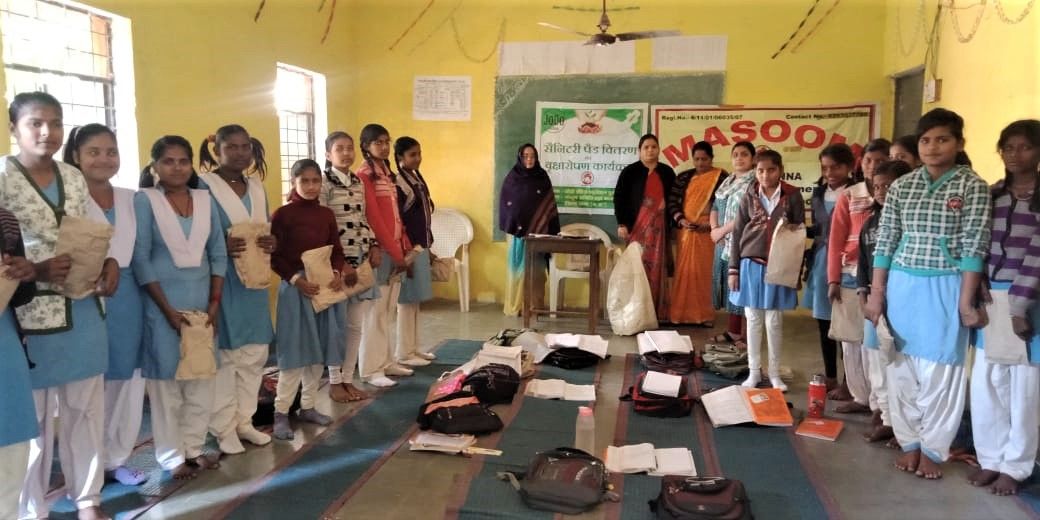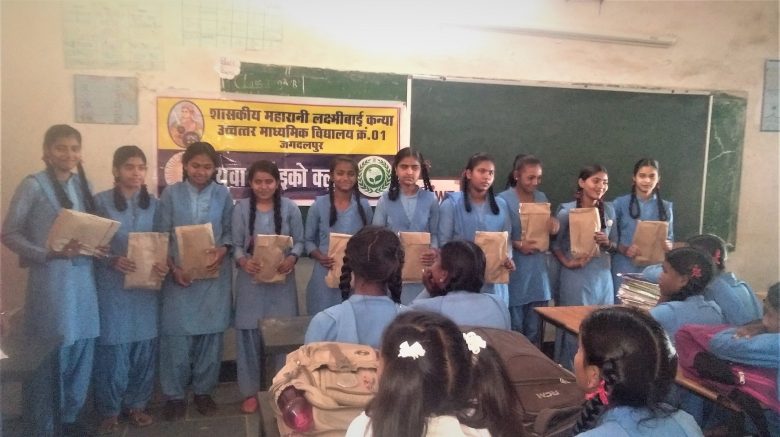Sarita (changed name) needs a week’s leave from her work to go to her village in Maharashtra. When her employer asked the reason, she replied that she needs to be there for a ceremony. Her younger daughter has now “grown-up” by reaching menarche. She said there was going to be a pompous celebration with all relatives and neighbours present. The girl will be dolled-up liked a bride and made to sit in a room decorated with flowers. Just as the employer begins to think about why people make a big deal about menstruation when even rural India appears to be progressive enough to celebrate it, she got her answer.
Sarita mentioned that while people present in the ceremony shower the girl with gifts, ornaments, and blessings for entering a fertile age, things will change soon thereafter. The girl won’t be allowed to touch anything in the house or enter the prayer room, and she will sleep in a separate room for nine days.
On the other hand, Koovalapuram, a village near Madurai, has a different ‘arrangement’ for menstruating women. During their period, women are forced to stay in isolated rooms, referred to as ‘guesthouses’ meant for ‘impure’ women. They are not allowed to cook food or share utensils, and people treat them as untouchables.
These are only a few examples that show how many in India still treat a perfectly normal, monthly biological phenomena. Urban cities have their unique challenges with period taboos but the information is easily accessible unlike in villages. Also, many more people are spreading awareness in urban areas than in rural.
The rural potential
Females make up about 48% of the rural population in India. The majority of the female workforce in India (81.3%) are from rural areas.
Most of them work in fields that involve manual labour. Others contribute to running households and nurturing families. In many communities, they are a significant source of livelihood.
Rural women can become key drivers of growth in our economy and preserving culture. They possess a wealth of traditional knowledge, expertise, and skills in agriculture and entrepreneurship.
Sadly, the potential of this deserving population remains under-realized because of a lack of facilities and recognition. On the social front, they face many hurdles due to gender-based discrimination.
One of these unnecessary and pressing hurdles is taboos related to menstruation.

Myths and stories
All these negative perceptions about menstruation stem from myths that have been prevalent for ages. From odd to outrageous -the range of fallacies out there is mind-boggling.
Pickles can rot, food can get spoilt, and plants can die if a menstruating woman touches them. She is not eligible to pray as her energy is negative nor work because her body-composition is off. She emits dangerous rays during her period, and her scent can cause animals to attack. Being around men and children is off-limits as she can corrupt their minds. Whatever she touches needs to be purified. If she doesn’t follow the rules, her wrong actions will bring destruction.
Sometimes, the stigma comes sugar-coated as a provision for women to rest and recuperate. People argue that women lose blood, so they should not be allowed to work or pray. But as it turns out, it has more to do with discrimination out of fear than gratitude for women or genuine concern about their health. This kind of forced ‘rest’ for healthy menstruating people does more damage than any other challenge of living a productive life.
Where did all this begin?
The notion that menstrual fluids from a woman’s body are impure or dirty is not limited to a single culture or religion. Countries, tribes, and communities everywhere have their versions of rules or restrictions on women during their menstruation period. The basic premise behind all these rules is a woman during her periods is either impure, unworthy, or even harmful.
Cultural and religious biases have led people to propel pseudo-scientific claims about how proximity to a menstruating woman is harmful. These beliefs are so deeply planted in girls’ minds that it may seem hard to challenge this social conditioning that their grandmothers, mothers, and sisters have imbibed.
These limiting assumptions are factually incorrect and derail a woman’s life in too many ways to overlook.
But before we get into how we need to answer the why. So, let’s first separate the facts from misinformation with a little science.
What is menstrual fluid?
Strictly biologically speaking, menstrual fluid has all the nutrients, flesh, and blood that the body could have used to develop an embryo or a baby if the egg got fertilized.
It is a mix of blood and tissues from the lining in the uterus called the endometrium that develops to prepare the body for pregnancy. Like skin, RBC, and other cells in the body, the endometrium regenerates itself when it is no longer useful. Once the uterus sheds it, a new lining will form.
Additionally, there are hormones and secretions from reproductive organs with water and electrolytes. Vaginal flora or bacteria (mainly lactobacilli) secretes enzymes that create a mildly acidic pH. All this prevents yeast and other bacterial infections.
Progesterone, a hormone, is responsible for the heat generated in the body during this time. This heat keeps microbes away from our bodies.
What it is not
Contrary to popular belief, if menstrual blood had anything toxic or harmful, that would mean that fetuses grow in a toxic environment before they are born, which is certainly not true.
Menstruation is not excretion, either. Excretion means removing potentially harmful products from the body produced during metabolism. Unlike urine, stools, or sweat, menstrual blood is not a waste by-product.
Secretion means releasing substances that serve a function in the body. We could say that this fluid includes secretions that happen outside the body.
So no, menses are not the body’s way of getting rid of toxins. It is a part of the monthly reproductive cycle that produces hormones to keep a woman’s body functioning well and away from infections.
What is unhygienic then?
The only time when the menstrual fluid, like any other bodily fluid, becomes contaminated is when it comes in contact with germs and bacteria from outside the body. Hence, it is crucial to maintain cleanliness and hygiene during menstruation to avoid getting infections, just as during any other body function. If sanitary towels and tampons are not changed/washed frequently, they can be a breeding ground for bacteria.
There is no reason to believe that period-blood is dirty or polluted, nor does it contain anything harmful.
It is certainly not helpful to dismiss this important topic as a ‘private concern’ of ladies. In 2014, the United Nations declared menstrual health as a human right and a public health matter.

Perils of period-shaming
The ordeals faced by rural women, particularly in low-income communities, don’t just stop at inconveniences. The influence of negative social attitudes about menstruation can leave a severe impact on their lives.
Lack of awareness
Even today, in many rural areas, schools don’t teach girls about menstruation as a separate topic, nor do families equip daughters with adequate information. Though things are gradually changing and NGOs and organizations are making efforts, it is still a long way to go.
Poor menstrual health
What’s worse is many women do not have access to sanitation facilities near work- and they do not even ask. It leads to them suffering in silence while using unsanitary means to soak bleeding. Those who use cloth sanitary pads struggle to maintain them well, as they are ashamed to hang them to dry in public. It defeats the purpose of otherwise comfortable and hygienic-sanitary products.
Stunted education and quality of life
Many girls have to miss school during menses, while some drop-out. Some of them are even married in their teens thereby diminishing their future potential.
Hampered work and productivity
If women face menstrual health issues at work, they can barely talk about it there – let alone receiving help or support. Instead, they are either sacked or forced to quit.
Psychological impact
When people make a woman feel ashamed for how her body works, it doesn’t just affect her external world. Her mental health suffers too. Her confidence to engage in other activities during menstruation shrinks, and reduced social interaction and isolation further increase the distress.
Lack of Approachability
While some women may discuss it among themselves in hushed tones or even feel good about it, communication hits the breaks when public discourse is needed. It is hardly possible to discuss any pain or discomfort with males- and most of the young boys do not even have clue about this cycle.
Unchecked Menstrual pollution
Although many government schools in rural India distribute sanitary pads to girls, these are mostly disposables that come with their drawbacks. Further, education about the safe disposal of disposable pads is still inadequate. The result is improper waste management and increased pollution.
Ineffective policy implementation
Menstrual Hygiene Management (MHM) programs aim to increase menstrual health and awareness among school-going girls at the policy level. However, these policies can lose their effect if people are not willing to even talk about them.

Conclusion
Women in rural India make up a significant portion of our population and are full of potential. However, myths and stigmas in society adversely impact their lives in various ways. It is a need of the hour to debunk those myths with correct information so that girls and women in rural areas can avail themselves of equal opportunities and lead their best lives.
It is often considered that men have jointly made the menstruation cycle something to abhor and despise, which can help them humiliate the stronger sex and provide men with a weapon to ‘keep women in their place’!

